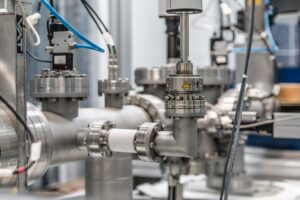 Barrel pumps, also known drum pumps, offer a safe and easy way to transfer and dispense chemicals from barrels or drums. There are various models, accessories and tube lengths to meet industry preferences. Some drum pumps can be operated manually using handles, plungers or levers to dispense the fluid.
Barrel pumps, also known drum pumps, offer a safe and easy way to transfer and dispense chemicals from barrels or drums. There are various models, accessories and tube lengths to meet industry preferences. Some drum pumps can be operated manually using handles, plungers or levers to dispense the fluid.
How Do They Work?
Processing and manufacturing plants rely on barrels extensively (about 100 to 200lts) to transfer and store chemicals and reagents. They are too heavy to lift and dispense or empty out the contents safely. With barrel pumps the fluids can be transferred from the containers safely and effectively.
Barrel pumps have a motor section, the vertical immersion pump section. The motor is found on top of the immersion tube on the outside part of the container. The immersion tube is as long as the depth of the container and fits through it. The tube is usually sealed to the opening found at the top part of the container. Immersion tubes come in different lengths to cater for different container depths. They also come in different materials to transfer the chemicals safely.
The pump section is found at the lower end of the immersion tube and is usually driven from the top part of the immersion tube by an extended shaft then protected using a sealed column. The liquid being pumped flows between the sleeve and the tube to the discharge port found at the motor end of the immersion tube.
Barrel pumps used for liquids with low or medium viscosity rely on extended centrifugal pumps that come with multiple, double or single impellers. These impellers rotate to discharge the liquid upward into the tube and outwards through a port found at the top of the immersion tube. For heavily and medium viscous fluids, positive displacement pumps are the most suitable.
For medium viscosity fluids, especially up to 2000cP, the best compressors with PTFE screw-type lifting are used. Some of the applications include the transfer of paints, inks, solvents and food products. For liquids with higher viscosities (especially up to 100,000cP), the most suitable option is a progressive cavity design.
Some of the typical applications include the transfer of solvents, resins, oils, waxes, glycerine, gear lube, adhesives, lotions, silicone, honey, polymers, juice concentrate, corn syrup, hair and bath gel and much more. There are FDA-compliant material options available for use.
What Are The Main Features Of A Barrel Pump?
Barrel/drum pumps are made up of several components that are in contact with the fluid being pumped as well as the outer pump tube material. The wetted parts should be resistant to corrosion. Also, if the fluid being transferred is combustible and flammable, it should be safe to use at the operating temperature. The pump tubes and other parts are available in 316 stainless steel, polypropylene, CPVC, PVDF and pure polypropylene.
A lot of manufacturers offer a wider range of immersion tubes in various lengths and interchangeable motors. As such, it’s easy to customise barrel pumps for different containers and operating environments. A motor can be effortlessly connected and disconnected to be used with another pump tube. If there is no electrical supply, air-powered motors are the best choice.
Barrel pumps can be disassembled in the field and the parts replaced individually. The container size determines the tube length. For instance, a 45 gallon/200 litre barrel needs a 100cm tube. 15- and 30-gallon containers use shorter tubes.